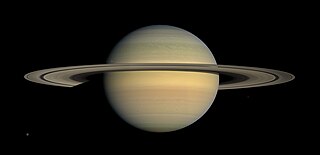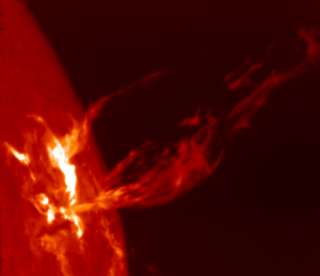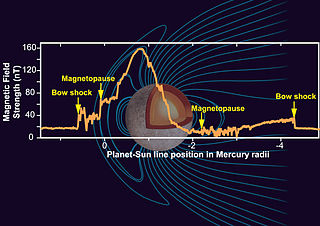Related Research Articles

In astronomy and planetary science, a magnetosphere is a region of space surrounding an astronomical object in which charged particles are affected by that object's magnetic field. It is created by a celestial body with an active interior dynamo.

Jupiter is the fifth planet from the Sun and the largest in the Solar System. It is a gas giant with a mass more than two and a half times that of all the other planets in the Solar System combined, but slightly less than one-thousandth the mass of the Sun. Jupiter is the third brightest natural object in the Earth's night sky after the Moon and Venus, and it has been observed since prehistoric times. It was named after the Roman god Jupiter, the king of the gods.

Saturn is the sixth planet from the Sun and the second-largest in the Solar System, after Jupiter. It is a gas giant with an average radius of about nine and a half times that of Earth. It has only one-eighth the average density of Earth; however, with its larger volume, Saturn is over 95 times more massive.

Earth's magnetic field, also known as the geomagnetic field, is the magnetic field that extends from Earth's interior out into space, where it interacts with the solar wind, a stream of charged particles emanating from the Sun. The magnetic field is generated by electric currents due to the motion of convection currents of a mixture of molten iron and nickel in Earth's outer core: these convection currents are caused by heat escaping from the core, a natural process called a geodynamo. The magnitude of Earth's magnetic field at its surface ranges from 25 to 65 μT. As an approximation, it is represented by a field of a magnetic dipole currently tilted at an angle of about 11° with respect to Earth's rotational axis, as if there were an enormous bar magnet placed at that angle through the center of Earth. The North geomagnetic pole actually represents the South pole of Earth's magnetic field, and conversely the South geomagnetic pole corresponds to the north pole of Earth's magnetic field. As of 2015, the North geomagnetic pole was located on Ellesmere Island, Nunavut, Canada.

In physics, the dynamo theory proposes a mechanism by which a celestial body such as Earth or a star generates a magnetic field. The dynamo theory describes the process through which a rotating, convecting, and electrically conducting fluid can maintain a magnetic field over astronomical time scales. A dynamo is thought to be the source of the Earth's magnetic field and the magnetic fields of Mercury and the Jovian planets.

The interplanetary medium (IPM) or interplanetary space consists of the mass and energy which fills the Solar System, and through which all the larger Solar System bodies, such as planets, dwarf planets, asteroids, and comets, move. The IPM stops at the heliopause, outside of which the interstellar medium begins. Before 1950, interplanetary space was widely considered to either be an empty vacuum, or consisting of "aether".
In theoretical physics, a no-go theorem is a theorem that states that a particular situation is not physically possible. Specifically, the term describes results in quantum mechanics like Bell's theorem and the Kochen–Specker theorem that constrain the permissible types of hidden variable theories which try to explain the apparent randomness of quantum mechanics as a deterministic model featuring hidden states.

The magnetosphere of Saturn is the cavity created in the flow of the solar wind by the planet's internally generated magnetic field. Discovered in 1979 by the Pioneer 11 spacecraft, Saturn's magnetosphere is the second largest of any planet in the Solar System after Jupiter. The magnetopause, the boundary between Saturn's magnetosphere and the solar wind, is located at a distance of about 20 Saturn radii from the planet's center, while its magnetotail stretches hundreds of Saturn radii behind it.
The magnetic Reynolds number (Rm) is the magnetic analogue of the Reynolds number, a fundamental dimensionless group that occurs in magnetohydrodynamics. It gives an estimate of the relative effects of advection or induction of a magnetic field by the motion of a conducting medium, often a fluid, to magnetic diffusion. It is typically defined by:
The solar dynamo is a physical process that generates the Sun's magnetic field. It is explained with a variant of the dynamo theory. A naturally occurring electric generator in the Sun's interior produces electric currents and a magnetic field, following the laws of Ampère, Faraday and Ohm, as well as the laws of fluid dynamics, which together form the laws of magnetohydrodynamics. The detailed mechanism of the solar dynamo is not known and is the subject of current research.

Peter Goldreich is an American astrophysicist whose research focuses on celestial mechanics, planetary rings, helioseismology and neutron stars. He is the Lee DuBridge Professor of Astrophysics and Planetary Physics at California Institute of Technology. Since 2005 he has also been a professor at the Institute for Advanced Study in Princeton, New Jersey. Asteroid 3805 Goldreich is named after him.

A flux tube is a generally tube-like (cylindrical) region of space containing a magnetic field, B, such that the cylindrical sides of the tube are everywhere parallel to the magnetic field lines. It is a graphical visual aid for visualizing a magnetic field. Since no magnetic flux passes through the sides of the tube, the flux through any cross section of the tube is equal, and the flux entering the tube at one end is equal to the flux leaving the tube at the other. Both the cross-sectional area of the tube and the magnetic field strength may vary along the length of the tube, but the magnetic flux inside is always constant.

The interplanetary magnetic field (IMF), now more commonly referred to as the heliospheric magnetic field (HMF), is the component of the solar magnetic field that is dragged out from the solar corona by the solar wind flow to fill the Solar System.

The magnetosphere of Jupiter is the cavity created in the solar wind by the planet's magnetic field. Extending up to seven million kilometers in the Sun's direction and almost to the orbit of Saturn in the opposite direction, Jupiter's magnetosphere is the largest and most powerful of any planetary magnetosphere in the Solar System, and by volume the largest known continuous structure in the Solar System after the heliosphere. Wider and flatter than the Earth's magnetosphere, Jupiter's is stronger by an order of magnitude, while its magnetic moment is roughly 18,000 times larger. The existence of Jupiter's magnetic field was first inferred from observations of radio emissions at the end of the 1950s and was directly observed by the Pioneer 10 spacecraft in 1973.

A stellar magnetic field is a magnetic field generated by the motion of conductive plasma inside a star. This motion is created through convection, which is a form of energy transport involving the physical movement of material. A localized magnetic field exerts a force on the plasma, effectively increasing the pressure without a comparable gain in density. As a result, the magnetized region rises relative to the remainder of the plasma, until it reaches the star's photosphere. This creates starspots on the surface, and the related phenomenon of coronal loops.

The habitability of natural satellites is a measure of their potential to sustain life in favorable circumstances. Habitable environments do not necessarily harbor life. Natural satellite habitability is a new area that is significant to astrobiology for various reasons, the most important of which being that natural satellites are expected to outnumber planets by a large margin, and it is projected that habitability parameters will be comparable to those of planets. There are, nevertheless, significant environmental variables that affect moons as prospective alien life locations. The strongest candidates for natural satellite habitability are currently icy satellites such as those of Jupiter and Saturn—Europa and Enceladus respectively, although if life exists in either place, it would probably be confined to subsurface habitats. Historically, life on Earth was thought to be strictly a surface phenomenon, but recent studies have shown that up to half of Earth's biomass could live below the surface. Europa and Enceladus exist outside the circumstellar habitable zone which has historically defined the limits of life within the Solar System as the zone in which water can exist as liquid at the surface. In the Solar System's habitable zone, there are only three natural satellites—the Moon, and Mars's moons Phobos and Deimos —none of which sustain an atmosphere or water in liquid form. Tidal forces are likely to play as significant a role providing heat as stellar radiation in the potential habitability of natural satellites.
Ap and Bp stars are chemically peculiar stars of spectral types A and B which show overabundances of some metals, such as strontium, chromium and europium. In addition, larger overabundances are often seen in praseodymium and neodymium. These stars have a much slower rotation than normal for A and B-type stars, although some exhibit rotation velocities up to about 100 kilometers per second.

Neptune is the eighth planet from the Sun and the farthest known planet in the Solar System. It is the fourth-largest planet in the Solar System by diameter, the third-most-massive planet, and the densest giant planet. It is 17 times the mass of Earth, and slightly more massive than its near-twin Uranus. Neptune is denser and physically smaller than Uranus because its greater mass causes more gravitational compression of its atmosphere. It is referred to as one of the solar system's two ice giant planets. Being composed primarily of gases and liquids, it has no well-defined "solid surface". The planet orbits the Sun once every 164.8 years at an average distance of 30.1 AU. It is named after the Roman god of the sea and has the astronomical symbol , representing Neptune's trident.

Mercury's magnetic field is approximately a magnetic dipole apparently global, on planet Mercury. Data from Mariner 10 led to its discovery in 1974; the spacecraft measured the field's strength as 1.1% that of Earth's magnetic field. The origin of the magnetic field can be explained by dynamo theory. The magnetic field is strong enough near the bow shock to slow the solar wind, which induces a magnetosphere.
The interchange instability is a type of plasma instability seen in magnetic fusion energy that is driven by the gradients in the magnetic pressure in areas where the confining magnetic field is curved.
References
- 1 2 Cowling, T.G. (1934). "The magnetic field of sunspots". Monthly Notices of the Royal Astronomical Society . 94: 39–48. Bibcode:1933MNRAS..94...39C. doi: 10.1093/mnras/94.1.39 .
- ↑ Zeldovich, Y. B. (1957). The magnetic field in the two-dimensional motion of a conducting turbulent fluid. Sov. Phys. JETP, 4, 460-462.